Work Safely
In this section there are some specific details related to working safely at our facilities. These are not exhaustive lists of all possible hazards or regulations, but a general guide to some of the most relevant for working safely at our facilities. If you are in doubt about something, always contact your local Aarhus University contact before doing it.
Before starting experiments you should discuss your plan of work
and any appropriate issues related to safety with your local contact.
For example, if you are to work with gas bottles, chemicals, cryogenics, lasers or electrical equipment, ensure that you have been instructed in what you are and aren’t allowed to do and how to work safely with them.
Electrical safety
Electrical currents can directly affect the human body in several ways, such as causing muscle spasms, burns to tissues and organs, and cardiac arrest. If a person is healthy, short-term currents need only exceed 30 mA in order to be life-threatening.
Visitors to the facilities should not carry out any work on electrical installations, open or modify power supplies or other electrical equipment unless directed that they may do so by a local contact.
Power
Most electrical power installations at the department are fitted with RCD / HPFI relays, which act to cut off the supply if a non-standard return of current occurs via e.g. a human to ground.
- It is very important that all equipment is correctly grounded, therefore when you plug in a device ensure that it has the correct plug for the socket available.
The majority of Danish grounded plugs/sockets are 3-pin, as in the left image below, however, some appliances are shipped with only 2 pins with the ground connected at the edges of the plug/socket (“Schuko” right image).
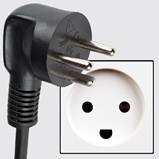 |
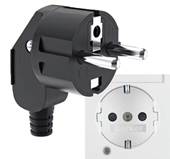 |
- A 2-pin plug (on the right) should never be plugged into a socket intended for the 3-pin plug, as the appliance will not be grounded. See your local contact to borrow an alternative power cable or an adaptor from Schuko to the Danish standard plug.
- Never work with exposed wires or cables that could allow contact with live power.
High voltage power supplies
There are a number of high voltage power supplies at the facilities (up to e.g. 60 kV), with some installations surrounded by wire fences and safety cut-off switches at the access points. High voltage power supplies of any kind should never be interfered with or modified by visitors.
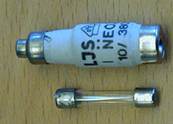 |
FusesFuses are installed to protect against excessive heat generation in an installation, or to secure appliances.Never change a fuse to one which has a higher current rating than that prescribed. There is always a reason why a fuse blows. Your local contact will assist in finding the appropriate fuse and in its replacement. |
Test leads
Only use test leads where the pins cannot be touched.
Safety plugs with fixed sheaths should preferably be used. These connectors can only be inserted into a corresponding safety socket. (left photo below)
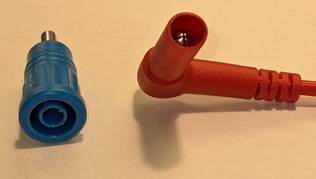 |
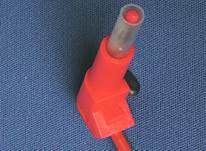 |
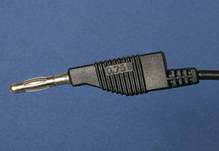 |
| Safety sleeve/bushing and plug with a fixed shield. | Plug with a sliding cover | Banana plug |
As these bushings are not yet mounted on all equipment, it may be necessary to use safety connectors with sliding cover.
Test leads with uncovered banana plugs (right image, above) must not be used.
If your measurements require it, your local contact will instruct you on how to work safely with the various electrical equipment.
Cryogenic substances
If you are to use cryogenic substances (liquid nitrogen or dry ice), ensure that you have been instructed on how to handle them properly by your local contact.
- Gloves and protective glasses should be worn when handling them and are available for use.
Safety concerning handling of Liquid Nitrogen
Liquid nitrogen (l-N2) is a clear fluid with a very low viscosity, it is extremely cold (-196° C), odourless, it is not flammable and it is inactive (does not react chemically).
The most common dangers while handling liquid nitrogen are:
- Contact hazard, especially eye injuries
If bare skin freezes onto surfaces that are cooled down with l-N2, it will cause severe damage, while sustained cooling of the skin can lead to frostbite. Inhalation of the cold gas can be very harmful to the lungs. Eyes are especially sensitive, so even small splashes or aerosols of l-N2 can cause immediate freezing of eye tissue with permanent damage. - Use protective glasses or face shield and gloves
- Avoid skin contact with l-N2, especially on cooled surfaces
- Be aware that, due to its low viscosity, l-N2 easily penetrates fabric
- If harm is done, rinse with lukewarm water and seek medical treatment if necessary
- Asphyxiation hazard (Suffocation)
l-N2 is not dangerous in itself, but its presence can cause suffocation, because the liquid converts into gas and the volume increases drastically. 1 litre of l-N2 converts into 700 l of gas, which will reduce the amount of oxygen in the room. If the oxygen content decreases enough, this will cause dizziness, nausea, vomit, fainting and death.
Be aware! There is no warning in advance! - Be careful not to spill l-N2
- Only use l-N2 in well ventilated rooms / areas
- When working with l-N2 in smaller rooms, use an oxygen monitor
- Never transport l-N2 in a lift with people. The l-N2 has to be transported on its own
- Explosion hazard
Since liquid nitrogen expands dramatically when it evaporates, incorrect storage can cause vigorous explosions. Large containers for l-N2 are therefore equipped with overpressure valves regulating the pressure in the container. Smaller containers are provided with loose lids.
Furthermore, please observe the following:
- Never drink liquid nitrogen
- Only store l-N2 in approved containers
- Avoid valves and evaporation tubes freezing and becoming blocked
- Never tighten a lid on a l-N2 container
- Be aware of the risk of the formation of liquid oxygen through condensation on the surface of a container of liquid nitrogen.
Safety concerning handling of dry ice (solid CO2)
Solid CO2 (dry ice) is a white solid and it is extremely cold (-79°C).
The most common dangers while handling dry ice are:
- Contact hazard
Skin contact can lead to severe frostbite, with skin cells becoming damaged very quickly. - Use protective glasses or face shield and gloves. Use tongs where possible to handle dry ice.
- Avoid skin contact with dry ice, never handle dry ice with bare hands.
- CO2 gas poisoning hazard
At temperatures above -79°C dry ice sublimes to be a gas, with ~ 1 kg giving 500 L of gas. At concentrations above 1000 ppm mild symptoms can be experienced, while at a concentration of 4% (40,000 ppm) CO2 exposure becomes immediately dangerous. Symptoms include: headaches, nausea, vomiting, dizziness, difficulty breathing, loss of consciousness and death. This is especially of concern in non- ventilated or confined spaces. - Always use and store dry ice in a well-ventilated area.
- Do not store dry ice in areas with limited ventilation such as cold rooms and walk-in fridges.
- When working with dry ice, use a CO2 monitor.
- Explosion hazard
Dry ice expands dramatically when it sublimates, storage in an enclosed container can result in it becoming pressurised and may explode if the gas is not able to escape. - Never store dry ice in a tightly sealed container. Styrofoam is an appropriate storage material, since it is both insulated and not airtight.
Furthermore, please observe the following:
- To dispose of dry ice, place it in a well-ventilated area at room temperature; the remainder of the ice will sublimate away.
- Never dispose of dry ice in a rubbish bin, chemical waste container or other waste container.
- Never dispose of dry ice in a sink, toilet or other fixture; the temperature difference can destroy the plumbing.
- Do not leave dry ice unattended in open areas.
- Discuss the use of gas bottles with your local contact and make sure that you know how to correctly operate the pressure regulator.
- Ensure that the gasket between the gas bottle and the regulator is in good condition and seals properly.
- Test all of the connections from the gas bottle and to the vacuum system for leaks before opening the gas bottle.
- Special care must be taken when using CO, a monitor must always be placed next to the bottle when it is in use.
Pressurised gas bottles
Gas bottles with pressures above atmospheric pressure must always be equipped with a pressure regulator.
Lasers
| Within the department there are a number of laboratories using lasers. This is always indicated on the doors of the laboratories and there will be an illuminated red light above the door indicating that the laser inside is in operation. Never just open a door to such a laboratory, always knock and wait for a response from someone inside before entering. |
Specifically for the ASTRID2 facility, there is a class 4 laser is present in the SGM4 laboratory in the beam line area of the ASTRID hall. This laser is safely enclosed within a curtained hutch, with a warning light above the hutch indicating when the laser shutter is open and operational. When the light is on, entry to the laser hutch is not permitted. The curtains around the hutch should not be modified or removed when the laser shutter is open. Specific training will be provided to any user who needs to operate the laser.
Working with vacuum/pumps
As a general rule, you must not alter any of the vacuum systems in use at the facilities. An exception to this is when your local contact has given you explicit permission to do so, and then only under their supervision.
Working at height
You should avoid working at height, other than for specifically designated tasks under the direction of your local contact. If it is required, ensure that the correct equipment is used, such as ladders or platforms designed specifically for the workplace.
Chemical safety
If you are going to work with chemicals during your visit, ensure that you have discussed the correct procedures with your local contact BEFORE starting work.
Protective Equipment
To ensure a good, safe, and healthy working environment in the laboratory, it is in many cases required that protective equipment is used when working in the laboratory. Protective equipment helps to increase the safety of the users and others present in the room.
All users of the chemistry laboratories are obliged to use protective equipment when required, as defined by the hazards indicated in safety data sheets for the chemicals in use. When using protective equipment, you must have received instruction in the use of them and be aware of any defects or deficiencies in the protective equipment.
Several different types of protective equipment can be used, the most common are: lab coats, fume cupboards and local exhaust ventilation, safety glasses and gloves.
Containers with chemicals should all be clearly labelled with the name, CAS number and any relevant hazard icons. These should already be present on commercially purchased samples containers. However, if a chemical is moved into another container after purchase, this should also include the information required for clear identification of the contents and the hazards associated with it.
Disposal of chemicals should only be carried out after discussion with your local contact.
For ASTRID2 users
There is a fume hood in the CD/IR preparation lab, the area indicated as “165” on the ASTRID2 overview figure. Before you use the fume hood, check that your local contact has obtained approval for you to do so.
Chemical spills
If you spill chemicals, you should immediately inform your local contact and ensure that others in the area are aware of the incident in case evacuation is required.
For ASTRID2 users
There is a chemical spill kit under the table next to the sink in the CD/IR preparation lab. In the kit you will find gloves, cloths, containers and other things to assist in clearing up spillages of chemicals. You should only do so if there is no danger to you through e.g. inhalation of vapours.
Eyewash stations
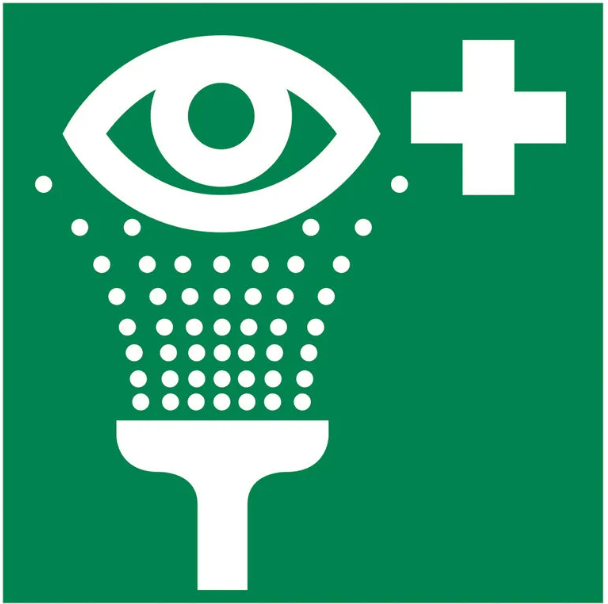 |
In case of chemicals or other irritants getting into the eyes, there are eyewash stations around the ASTRID2 hall and in the PEF, which are noted on the overview figures for the facilies. |
If you have any comments or questions related to this content, the test or procedure required to complete this, please contact .
Last Modified 19 September 2025